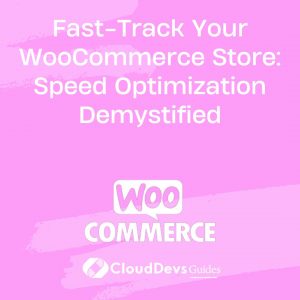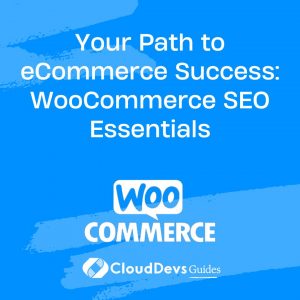Fast-Track Your WooCommerce Store: Speed Optimization Demystified
WooCommerce is a popular e-commerce platform for WordPress, empowering millions of online stores worldwide. However, as your online store grows and attracts more visitors, ensuring optimal performance becomes crucial. Slow-loading pages can lead to high bounce rates, decreased sales, and a poor user experience. In this blog post, we will explore various WooCommerce performance optimization techniques to help you enhance the speed and efficiency of your online store.

1. Choose a Reliable Hosting Provider
Your hosting provider plays a significant role in your WooCommerce store’s performance. Opt for a reputable hosting company that offers fast servers, SSD storage, and good scalability options. Managed WordPress hosting services like SiteGround, Bluehost, or WP Engine are popular choices as they specialize in optimizing WordPress and WooCommerce.
2. Utilize Caching
Caching is a technique that stores static HTML versions of your web pages to reduce server load and load times. Popular caching plugins like WP Super Cache, W3 Total Cache, or WP Rocket can dramatically improve your site’s performance. Configure them to cache your WooCommerce pages effectively while excluding shopping cart and checkout pages to ensure they remain dynamic.
3. Optimize Images
Images are often the largest contributors to page size, impacting load times significantly. Use tools like TinyPNG or Smush to compress and optimize your product images without compromising quality. Additionally, consider using the WebP image format, which offers better compression and browser support for faster loading.
4. Minify CSS and JavaScript
Minification involves removing unnecessary characters and whitespace from CSS and JavaScript files to reduce their size. You can achieve this by using plugins like Autoptimize or by enabling built-in options in caching plugins. Smaller file sizes lead to quicker page loading.
5. Content Delivery Network (CDN)
A Content Delivery Network distributes your website’s content across multiple servers worldwide. This reduces server load and decreases the time it takes for users to retrieve assets like images and scripts. Popular CDN services like Cloudflare or StackPath integrate seamlessly with WooCommerce.
6. Disable Unused Plugins and Themes
Too many active plugins and themes can slow down your WooCommerce site. Regularly review and deactivate any unnecessary plugins or themes. Ensure that your active plugins are well-coded and regularly updated to avoid potential conflicts.
7. Implement Lazy Loading
Lazy loading is a technique that defers the loading of non-essential content (e.g., images, videos) until the user scrolls down the page. This can significantly improve the initial page load time, especially on product category pages with numerous items.
8. Database Optimization
Regularly optimize your WordPress database by removing unnecessary data, such as post revisions, trashed items, and spam comments. You can use plugins like WP-Optimize or WP-Sweep to automate this process and keep your database lean and efficient.
9. Use a Lightweight Theme
Choosing a lightweight and well-coded theme is essential for WooCommerce performance. Themes like Astra, GeneratePress, or Storefront are optimized for speed and compatibility with WooCommerce. Avoid themes with excessive features you don’t need, as they can add unnecessary bloat.
10. Enable GZIP Compression
GZIP compression reduces the size of files sent from your server to the user’s browser, resulting in faster loading times. Many hosting providers enable GZIP compression by default, but you can also activate it via plugins or server configuration if needed.
11. Monitor and Optimize Third-Party Scripts
Excessive third-party scripts, such as tracking codes or social media widgets, can slow down your site. Review and minimize the number of external scripts you use, and consider asynchronous loading to prevent them from blocking page rendering.
12. Regularly Update WooCommerce and Plugins
Keeping your WooCommerce installation and plugins up to date is crucial for performance and security. Developers frequently release updates that include performance enhancements, bug fixes, and security patches. Always make sure you are running the latest versions.
Conclusion
WooCommerce is a powerful e-commerce platform, but it requires careful optimization to deliver the best performance to your customers. By implementing these WooCommerce performance optimization techniques, you can ensure that your online store loads quickly, provides a seamless shopping experience, and ultimately drives more sales. Regularly monitor your site’s performance and make adjustments as needed to stay ahead in the competitive e-commerce landscape. Remember, a fast and efficient store is more likely to convert visitors into loyal customers.
Table of Contents







